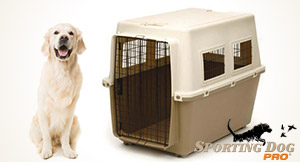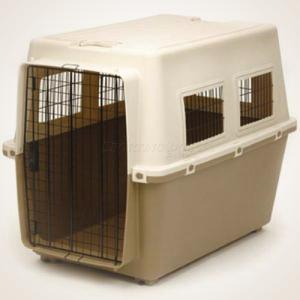You have no items in your shopping cart.
Tips for Crate Training a Puppy or Older Dog

If you just bought a new puppy or have an older dog that needs a safe and comfortable environment to call its own, then you should consider crate training your dog. Other than making a great bed for him to snuggle down in for the night, there are quite a few reasons dogs and their owners desire the crate method of training. For example, sometimes its necessary to manage your dog when you are unable to monitor him. Using the crate can prevent dangerous or destructive behavior like chewing on power cords or those brand new pair of shoes. Having a crate will also offer you a safe way to introduce a new dog to your household when the environment becomes hectic, or when he’s exhausted and needs to take refuge in his own confined sanctuary. A dog will usually take ownership of their little “home within a home” and often become territorial of their designated crate. Sometimes all you'll need is a regular plastic kennel, while some more anxious escape artist types will need an escape proof heavy duty aluminum dog crate. Professional trainers tend to lean towards the later.
House training is another way to make the most of your dog crate. Most dogs will not soil their sleeping quarters so you are able to train them to go to your designated outdoor spot just by using the crate method. Additionally, crate training can calm your dog when transporting them while you travel. Even on short car trips a crate can assure your dog that he is in a safe and secure environment. Often dogs will change their behavior while traveling or during a move. The crate will give your dog comfort so that he doesn't feel that his world changed on him, he still has his little home.
Proper crate training rules of thumb.
- Place the crate in a familiar part of the room that your dog already spends time in, like your living room, and keep a soft bed inside the crate. At first, remove the door so that your dog explore the crate at their leisure.
- Start feeding your dog inside the crate. Doing so will associate positive reinforcement with the environment of the crate. Ask him to enter the crate by using a term like "kennel".
- Once your dog becomes use to eating in the crate, begin closing him in after meals (when he is most satisfied and comfortable). Do this for only short periods of time so that he can become use to the positive confinement.
- Once your dog is comfortable with at least 30 minutes of crate time, begin crating him while you are away from the house. When you return, try not to make a big deal about your arrival. This is will ensure his safety inside the crate while he anxiously awaits you to let him out. Be sure to continue to crate him while you are home as well to make sure he doesn't relate being in the crate to loneliness.
- Finally, begin crating your dog at night, and start by keeping it closer to your bedroom so you can keep an ear out for any problems.
Consider these guidelines when using the crate for training or for housing. Always, avoid over confinement. A dog should never be left in the confinement of his crate for hours on end. There are suggested times for each age group, but for the most part, just make sure your dog is offered plenty of exercise and the opportunity to explore outside. If left longer than a few minutes make sure your dog has a safe toy to keep him occupied. Also, don’t forget that dogs are social animals and they require plenty of interaction and companionship outside of their crate. If your dog begins to use the bathroom inside of his crate (other than a very young puppy who hasn’t yet developed any control) then chances are he is spending too much time inside his crate.
One final thing to consider when crate training; the crate should not be used as a form of punishment. This will cause your dog to fear the crate and it will make training that much harder. It is perfectly ok to put your dog in the crate after bad behavior or to separate him from the environment that was causing the bad behavior, but deal with the bad behavior before you put him in his crate. Most importantly, ensure that they see the crate as a sanctuary and not a prison.
Choosing the best dog kennel for your dog.
There are many things to take into consideration when choosing a crate for your dog. Always consider the size of your dog in relation to the size of the crate. Avoid choosing a crate that is too small for your dog so he will not be cramped but, also try to stay away from a crate that is too large because a crate with too much room will encourage your dog to defecate in an unused corner. The crate should be long enough that your dog can lie down stretched out completely, and tall enough that your dog can stand completely up, without hunching over, with at least 3 inches or more above his head. It should also be wide enough that your dog can turn completely around in a circle. If these details are overlooked you can cause unnecessary complications for your dog both mentally and physically. And don’t forget, if you plan on flying on an airplane with your dog make sure that the crate you choose is airline approved.
Good luck, and happy training!













